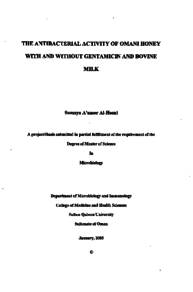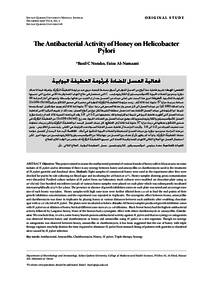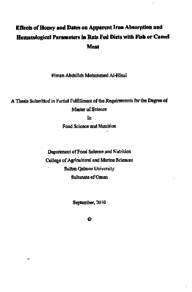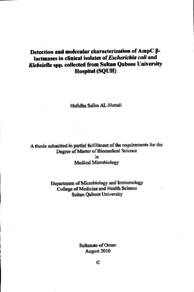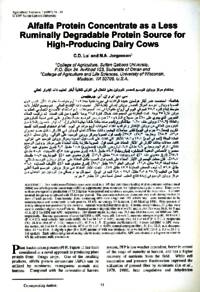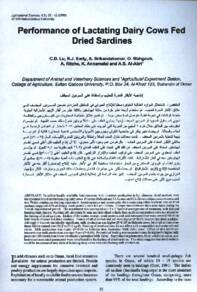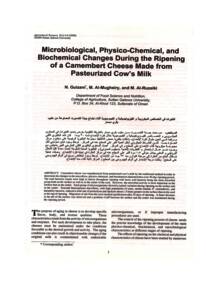Document
The antibacterial activity of Omani honey with and without gentamicin and bovine milk
Publisher
Sultan Qaboos University
Gregorian
2005
Language
English
Subject
English abstract
The aims of this study were to screen different Omani honey samples and different bovine milk samples for their antibacterial activities, and to test the synergistic activity of honey with gentamicin and honey with bovine milk using a control strain of Staphylococcus aureus. Thirty honey samples, from different regions of Oman, were investigated for their activity against Staphylococcus aureus (NCTC 6571) using an agar well diffusion technique. Marked variations in the antibacterial activity of the different honey samples were observed. Thirteen of the Omani honey samples (43%) showed excellent antiStaphylococcusaureus activity. Only two Omani honey samples (7%) showed poor activity, five samples (17%) showed fair activity and ten samples (33%) showed good anti-Staphylococcus aureus activity. One honey sample OH26, from Al Batinah region (Al Kaborah) showed the highest level of anti-Staphylococcus aureus activity (up to 1:8 dilution; 12.5% concentration). The antibacterial activity of OH26 was further investigated, separately, in the presence of either gentamicin or bovine milk using growth rate reduction method. This honey sample reduced the viable count of Staphylococcus aureus to 34% in thirty minutes, gentamicin alone was 79% while honey in combination with gentamicin was 90% within the period (P<0.05). The enhancement of the antibacterial activity by mixtures of honey and gentamicin was annulled when honey was heated to 50°C prior to the investigation. Four different milk samples (Al-Marai, Al-Rawabi, A'Safwa and Sohar) were investigated for their antibacterial activity. Two of the milk samples, Sohar and AlMarai, possessed anti-Staphylococcus activity by producing zones of inhibition of 18 and 20 millimeters, respectively, by the well diffusion method, while the remaining two samples Al-Rawabi and A'Safwa possessed no anti-Staphylococcus aureus activities. Using growth rate reduction method, Al-Marai and Al-Rawabi milk samples in the presence of honey had reduction rates of 67% and 69%, respectively, in two hours though individually they had no reduction rates (no reduction in viable counts). The reason why some bovine milk (Al-Marai) showed antibacterial activity by well diffusion method and lost the activity by growth reduction method is not clear but may be attributable to dilution of the active agent in the milk by the technique used or by the acquisition of exogenous iron ions outside lactoferrin content of the milk. The contribution of combining honey with gentamicin showed enhancement of the antiStaphylococcusaureus activity within the first thirty minutes. Combination of honey with bovine milk demonstrated improved anti-Staphylococcus aureus activity than the use of either alone but the improvement is not high enough to be described as synergistic. Though honey is used as food, medicine or as antiseptic, we feel honey when used with milk can offer faster killing rate of bacteria than either used alone.
Member of
Resource URL
Arabic abstract
هدف البحث الحالي هو دراسة أنواع مختلفة من العسل العماني وأنواع مختلفة من الحليب البقري ضد نوع من البكتيريا العنقودية وكذلك دراسة فاعلية العسل مخلوطا مع مضاد حيوي أو مخلوطا مع حليب البقر . تم دراسة 30 عينة مختلفة من العسل تم الحصول عليها من أرجاء مختلفة من السلطنة باستخدامطرق معملية ميكروبيولوجية معترف بها دوليا. لوحظ وجود اختلافات متباينة في النشاط المضاد للبكتيريا لمختلف نماذج العسل التي درست بعض أنواع العسل (13 نوع أعطت نشاط ضد بكتيري ممتاز بينما 10 أنواع من العسل كان نشاطها جيدا والبعض الآخر ضعيفا وبعضها لم يعطي أي نتائج ملحوظة ضد البكتيريا العنقودية. أحد أنواع العسل العماني (عينة رقم 26) تم الحصول عليها من منطقة الباطنة (الخابورة) أعطت أفضل النتائج ضد البكتيريا العنقودية . هذه العينة قللت نمو البكتيريا العنقودية بنسبة 34% خلال النصف ساعة الأولى بينما المضاد الحيوي (الجنتاميسين) قلل نمو البكتيريا بنسبة 79% في نفس الفترة الزمنية. عند خلط العينة 26 مع المضاد الحيوي (الجنتاميسين) تم تقليل نسبة نمو البكتيريا إلى 90% في الفترة نفسها ( 0 . 05 >P). لوحظ أنه عند تسخين خليط العسل مع المضاد الحيوي إلى درجة 50 د.م فان تعزيز النشاط الضد بكتيري يقل كثيرا تم أيضا دراسة أربعة أنواع من الحليب البقري (المراعي، الروابي، الصفوة ، صحار) لمعرفة نشاطهم المضاد للبكتيريا العنقودية . نوعيين فقط من الحليب أثبتت أن لها قدرة مضادة للبكتيريا(صحار والمراعي).عند دراسة خلط العسل العماني مع حليب( صحار والروابي) لوحظ تقليل نسبة نمو البكتيريا العنقودية. إن السبب من وراء وجود نشاط مضاد للبكتيريا لدى بعض أنواع الحليب البقري وليس كلها قد يعزى إلى اكتساب أيونات الحديد والأكسجين . أشارت الدراسة إلى أن العسل العماني يقلل نمو البكتيريا العنقودية وأن خلط العسل العماني مع المضاد الحيوي أو مع الحليب البقري يؤدي إلى تقليل عدد البكتيريا العنقودية أكثر من استخدام العسل لوحده.
Category
Theses and Dissertations

